Designed for outside broadcast trucks, Geithain’s compact monitors could easily find a home in music recording contexts where space is at a premium.
 There’s always been a need for ultra‑compact monitors, particularly in the world of professional broadcasting. Perhaps the best‑known example is the BBC‑designed LS3/5A, born in the mid 1970s specifically for the cramped environment of outside broadcast (OB) trucks. Whenever the BBC broadcast a live event, from sports events to classical concerts, there’d be a pair of LS3/5As in the truck. But the LS3/5A was a particularly BBC phenomenon, and national broadcast companies all over the world have had, and do have, their own favourite monitors. In Germany, monitor brand ME‑Geithain, a company that can trace their roots back to the 1960s, have long been a supplier to broadcast organisations, and their MO‑1 MKII model, the subject of this review, is the archetypal ultra‑compact broadcast monitor.
There’s always been a need for ultra‑compact monitors, particularly in the world of professional broadcasting. Perhaps the best‑known example is the BBC‑designed LS3/5A, born in the mid 1970s specifically for the cramped environment of outside broadcast (OB) trucks. Whenever the BBC broadcast a live event, from sports events to classical concerts, there’d be a pair of LS3/5As in the truck. But the LS3/5A was a particularly BBC phenomenon, and national broadcast companies all over the world have had, and do have, their own favourite monitors. In Germany, monitor brand ME‑Geithain, a company that can trace their roots back to the 1960s, have long been a supplier to broadcast organisations, and their MO‑1 MKII model, the subject of this review, is the archetypal ultra‑compact broadcast monitor.
While reviewing an overtly broadcast monitor might seem slightly off‑piste for the pages of Sound On Sound, the worlds of music recording, composition, production, mix and sound design can also call for compact monitoring, so there often is a role for products of this ilk. You’ve perhaps also noticed that the MO‑1 on review here is the MKII, but I was additionally supplied with a pair of MKIs to compare and contrast. I’ll cover some of the differences between the MKI and MKII later on.
The MO‑1 MKII really is pretty small, with external dimensions of 214 x 147 x 192mm (HxWxD) enclosing an internal volume of just 3.5 litres or so. Its enclosure is equipped on the side panels with tapped holes intended for the attachment of mounting hardware and, along with installation in compact studio spaces, I’d imagine ME‑Geithain have in mind compact multi‑channel (Atmos) applications.
On the front panel, behind a perforated metal grille, is a nominally 100mm‑diameter bass/mid driver with a concentrically located 19mm dome tweeter. Rather than being mounted at the apex of the bass/mid driver with the diaphragm taking on a secondary role of tweeter waveguide, as is the case with the majority of dual‑concentric driver arrays, the MO‑1 MKII tweeter is located further forward, approximately on the plane of the bass/mid driver surround. Mounting the tweeter on the bass/mid driver forward plane has the potential advantage of less modulation distortion appearing from the movement of the bass/mid diaphragm (which in a small speaker like this could be significant), but this style of concentric driver array is nevertheless relatively unusual these days, and is lower‑tech and less sophisticated than some other possible concentric driver architectures. For example, tweeters mounted at the bass/mid diaphragm apex are coincident as well as concentric: they are at the same position in space and not just on the same axis, so their time‑domain integration is potentially optimal. Furthermore, a tweeter located in front of the bass/mid driver can constitute a significant diffraction body at midrange frequencies and will potentially result in audible artefacts. But despite the potential disadvantages, the engineers at ME‑Geithain have employed this technique for many years and will undoubtedly have developed much technical expertise in optimising its behaviour and performance.
Great & Small
Somewhat surprisingly considering its diminutive dimensions, the MO‑1 MKII is a closed‑box speaker, and so eschews the potential power handling and maximum level gains of reflex loading. As I’ve described many times in these pages, closed‑box loading typically offers time‑domain benefits over reflex loading, but when it comes to very small monitors where power handling, distortion and maximum volume level are at a premium, the arguments in favour of reflex loading prevail for the vast majority of monitor manufacturers. ME‑Geithain may well have concluded that the difficulty of fitting a port of adequate diameter in such a small box swings the argument in favour of keeping the box closed.
This is a perfectly reasonable decision, but it does mean that the bass driver (and amplifier) has to work harder. While there’s nothing in ME‑Geithain’s description or the technical specification of the MO‑1 MKII to suggest that significant measures have been taken in the engineering of the bass/midrange to provide extra low‑frequency power handling, the specification does list a very healthy maximum SPL of 103‑108 dB at 1m from 150Hz upwards. The range in the specification reflects the fact that the MO‑1 MKII is equipped with optional low‑frequency EQ profiles, some of which reduce low‑frequency bandwidth and consequently will enable increased maximum level.
Round The Back
The rear panel is a relatively crowded place, and this is not only because it doesn’t offer much real estate; it’s also because the monitor is unusually blessed with connection and configuration facilities. Firstly, along with the expected IEC mains input and power switch, the MO‑1 MKII unexpectedly offers two balanced XLR analogue inputs. The two inputs can be selected individually using a rear push button, but can also be employed simultaneously to enable a single MO‑1 MKII to offer mono monitoring of a stereo signal. Amplification comprises Class‑D amplifier stages for the bass/mid driver and tweeter, each rated at 95 Watts, and the crossover frequency is 3.5kHz.
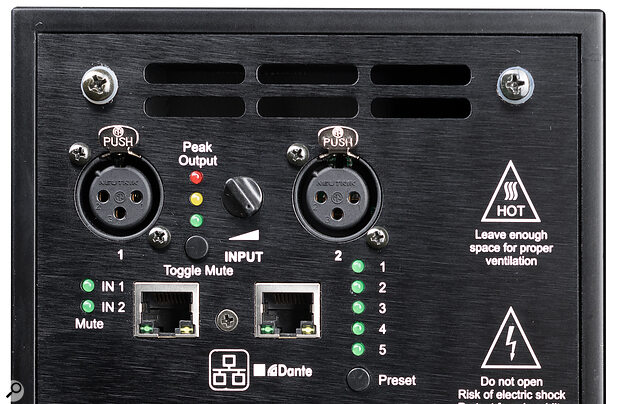 Unusually, the MO‑1 MKII features two analogue inputs, which sum internally, allowing you to monitor stereo signals in mono. On the digital side, two Ethernet ports provide Dante connectivity and remote control over the speaker’s DSP. The five EQ settings can be selected using the Preset button.
Unusually, the MO‑1 MKII features two analogue inputs, which sum internally, allowing you to monitor stereo signals in mono. On the digital side, two Ethernet ports provide Dante connectivity and remote control over the speaker’s DSP. The five EQ settings can be selected using the Preset button.
Located between the input sockets is an LED array that indicates signal presence and clipping, and a rotary knob that adjusts input sensitivity by ±6dB. The input sensitivity knob is variable rather than stepped and offers no indication of level, which is a bit of a shame because it means matching levels across a pair of monitors is potentially more complicated than it otherwise might be, unless of course you set the sensitivity at min or max. Below the input sockets are an input selection push button and two network sockets that enable MO‑1 MKIIs to be connected to a Dante audio‑over‑IP (AoIP) network. The network sockets also provide access to a macOS and Windows DSP control application that enables optional remote configuration of monitor settings. The Dante‑equipped MO‑1 MKII acts as a network switch, allowing for network daisy‑chaining. The control app allows for custom EQ’ing (up to 10 bands per input), and also displays the value of the input gain control, making it much easier to level‑match multiple monitors.
It was something of a surprise to find that the MO‑1 MKII is equipped for AoIP, but Dante (and the related AES67 network audio standard) is fast becoming the default means of moving audio from one place to another in broadcast and theatrical audio, so for the MO‑1 MKII’s primary role it’s probably all but obligatory. Dante is perhaps not hugely relevant yet for most Sound On Sound readers, but give it time: the march of AoIP into all realms of audio production is, I suspect, unstoppable. Having said that, a non‑Dante equipped version of MO‑1 MKII is also available at a significantly reduced price.
Finally there’s an array of five numbered LEDs and a selection button that scrolls through them. The numbers relate to five preset EQ curves that offer some frequency response profiles and low‑frequency roll‑off options, and as part of my usual acoustic measurement session, I investigated the result of selecting each one.
Measuring Up
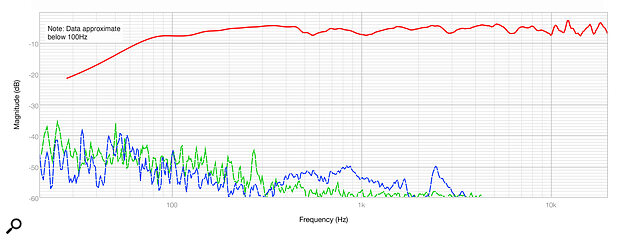 Diagram 1: The MO‑1 MKII’s on‑axis frequency response (red trace), measured at 75dB SPL at 1m. Second and third harmonics are shown in green and blue, respectively.
Diagram 1: The MO‑1 MKII’s on‑axis frequency response (red trace), measured at 75dB SPL at 1m. Second and third harmonics are shown in green and blue, respectively.
Diagram 1 shows the MO‑1 MKII’s frequency response and harmonic distortion, measured at 2m on its driver axis. The sound pressure level was 75dB at 1m. The overall frequency response curve is slightly untidy but not worryingly so, and the harmonic distortion is reasonably well controlled, being generally better than ‑45dB from 150Hz upwards. Diagram 2 is a repeat of Diagram 1 but with the SPL increased to 85dB at 1m. The MO‑1 MKII is working hard now and that shows in increased distortion, especially at low frequencies. ME‑Geithain’s published specification claims harmonic distortion at 85dB SPL of below ‑40dB (200Hz‑10kHz), and that agrees reasonably well with the results I obtained. A genuinely compact monitor is never going to achieve vanishingly low distortion, especially at low frequencies, but the MO‑1 MKII makes a pretty good fist of things.
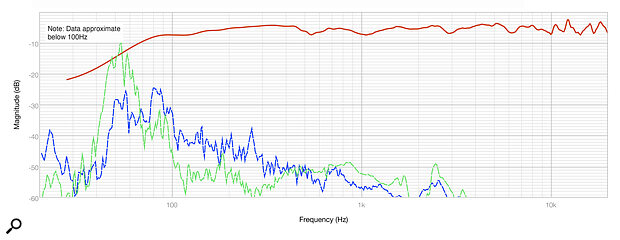 Diagram 2: As Diagram 1, but measured at 85dB SPL. The distortion products rise concomitantly.
Diagram 2: As Diagram 1, but measured at 85dB SPL. The distortion products rise concomitantly.
Diagram 3 shows the effect of the five EQ options available on the MO‑1 MKII rear panel. Option 1 (red) is the default/flat mode; options 2 and 3 (green and blue) offer varying degrees of restricted LF bandwidth; option 4 (orange) slightly reduces both LF and low‑midrange output; and option 5 slightly reduces LF output to compensate for boundary placement. Options 2 and 3 are optimised for use with subwoofers, and I understand that ME‑Geithain are planning to launch the BASIS‑10 sub, designed specifically to work with the MO‑1 MKII, in the first half of 2025.
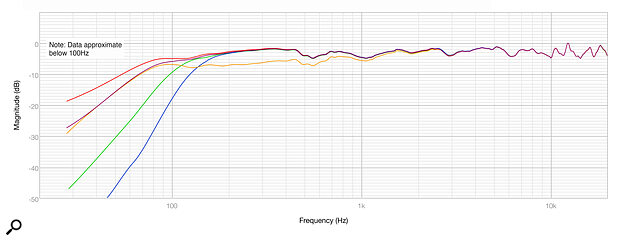 Diagram 3: Comparing the EQ presets 1‑5 (respectively: red, green, blue, orange, purple).
Diagram 3: Comparing the EQ presets 1‑5 (respectively: red, green, blue, orange, purple).
Diagram 4 shows the axial amplitude response again, but overlaid with a measurement made 20 degrees off axis. It confirms one of the fundamental advantages of the concentric driver architecture, in that the off‑axis curve shows a generally gentle divergent trend from the axial response, with no major discontinuities.
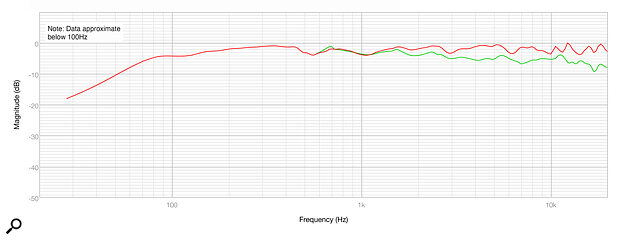 Diagram 4: Comparing the axial response (red trace) with the response measured 20 degrees off‑axis (green).
Diagram 4: Comparing the axial response (red trace) with the response measured 20 degrees off‑axis (green).
Finally, of course I couldn’t resist comparing old and new, and putting one of the MO‑1 MKIs in front of the measuring microphone. Diagram 5 is the result, and primarily it shows just how much more low‑frequency bandwidth the MO‑1 MKII offers, but also that its frequency response is generally more linear. I’ve not included it in the diagram, but the MKI also shows significantly higher levels of harmonic distortion than the MKII.
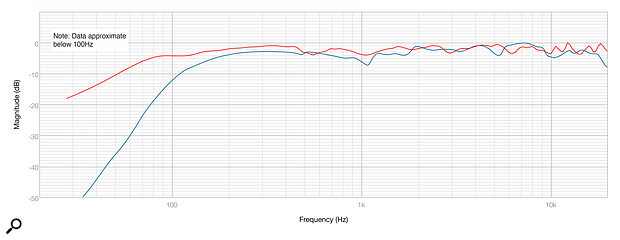 Diagram 5: Comparing the MO‑1 MKI’s response (blue trace) to that of the MKII (red).
Diagram 5: Comparing the MO‑1 MKI’s response (blue trace) to that of the MKII (red).
In Use
So the MO‑1 MKII definitely measures like a rather more ‘grown‑up’ monitor than the MKI, but how does it sound? Positioned alongside my regular Neumann KH150s and Atmos system Dynaudio BM5 MKIIIs, the MO‑1 MKII sounded unmistakably like a small monitor, but it wasn’t outclassed in terms of its fundamental ability to do the job. MO‑1 MKII bass is clearly curtailed in terms of bandwidth and level, but if I didn’t ask too much of it by playing fast and loose with the volume control it remained usefully communicative of pitch, tonal quality and dynamics. And if I did ask too much, the MO‑1 MKII complained in a very obvious way, with its bass/mid driver making uncomfortable noises and its front‑panel LED flashing red.
Further up from bass into the midrange, I found the MO‑1 MKII fundamentally capable and informative, but I was aware of a slightly veiled character in the upper vocal region — a mild heaviness of tone and perhaps a lack of ultimate clarity and detail. A little midrange character is nowhere near being a dealbreaker, though, firstly because the MO‑1 MKII’s role is primarily about doing a ‘first draft’ monitoring job in non‑ideal locations, and secondly because its character would be reasonably easy to learn and accommodate. I also found a touch of ‘presence band’ EQ boost around 4kHz helped things along by masking the character a little and lifting an area where I felt the MO‑1 MKII was a little reticent. I’m usually reluctant to start ‘re‑voicing’ a review monitor with EQ, because that’s not really the job here, but I was genuinely impressed with the basic quality and ability of the MO‑1 MKII, so couldn’t help myself (also, my new Audient ORIA interface makes EQ tweaks so easy!).
Moving on up, the MO‑1 MKII’s tweeter is very adequately endowed with neutral high‑frequency detail that doesn’t either draw undue attention to itself or potentially become wearing. If anything, I actually found the default high‑frequency balance of the MO‑1 MKII to be a little undercooked, and wondered if rear‑panel EQ option 4 might suit me a little better, but I found it went a little too far the other way.
Designing and engineering a truly compact monitor that works as well as the MO‑1 MKII is a notable achievement.
Keep On Truckin’
Designing and engineering truly compact monitors is one of the most difficult of all electro‑acoustic jobs, because they unavoidably butt up against the pesky laws of physics. For example, when designing a more conventionally sized nearfield monitor, adding, say, a couple of centimetres to the external dimensions multiplies up to a significant internal volume increase yet doesn’t really have much effect on the monitor’s practical applications. Add a couple of centimetres to a compact monitor’s dimensions and you risk engineering it out of a job. Similarly, if higher maximum SPL is required of a larger nearfield monitor, you can just specify a bit more diaphragm area from a larger bass driver, but you can’t do that in a compact monitor because a larger driver won’t fit. So designing and engineering a truly compact monitor that works as well as the MO‑1 MKII is a notable achievement and one that ME‑Geithain deserve to be congratulated on. Its useful configuration and EQ facilities only add to its appeal and practicality.
As a Sound On Sound reader you probably don’t often find yourself in an outside broadcast truck, but if your needs are for a highly portable and versatile compact monitor that offers genuinely professional performance, the MO‑1 MKII definitely ought to be on your list of possibles.
Alternatives
Suggesting alternatives to the MO‑1 MkII is slightly tricky, because if its Dante option and connection versatility are important, there’s little competition. If your needs are simply for a high‑performance compact monitor, though, then the Neumann KH80, Genelec 8320 and Quested V2104 probably also ought to be on your list.
Pros
- Truly compact.
- Genuine monitor‑worthy performance.
- Versatile connection and configuration options.
- Dante‑compatible.
Cons
- Slight midrange coloration.
- Relatively limited maximum volume.
Summary
The MO‑1 MKII belies its tiny dimensions to offer some genuine high‑performance monitoring quality.
Information
£2599.20, Dante version £2983.20. Prices are per pair, including VAT.
Sound‑Link +44 (0)1869 600817.
€2270 (approx $2398), Dante version €2606 ($2753). Prices are per pair, excluding tax & shipping.
